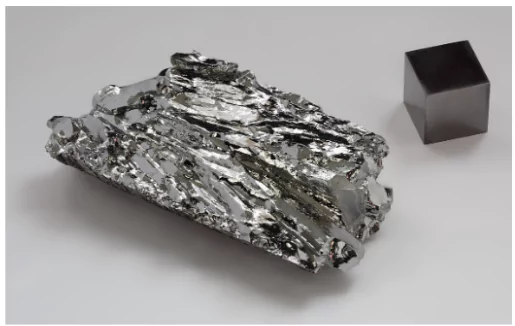Californium

|
Recently, Bihar police seized what they thought was a highly unusual and dangerous contraband: 50 grams of the highly radioactive metal Californium
About Californium:
- About: Californium is a silvery-white synthetic radioactive metal with the atomic number 98 on the periodic table.
- Californium is a member of the actinide series in the periodic table.
- It is not found naturally and is produced through nuclear reactions, specifically by bombarding curium with helium ions.
- First made in 1950 at Berkeley, California — from where it derives its name — Californium
- Californium is known for its intense radioactivity and is considered both valuable and hazardous.
- Isotopes: The element’s most notable isotopes include
- Cf-251, which has a half-life of 898 years and is the most stable
- Cf-249 and Cf-250, which have shorter half-lives.
- Properties : It is a very strong neutron emitter and is used in portable metal detectors for identifying gold and silver ores
- In nuclear reactors: It serves as a neutron source to initiate and sustain nuclear reactions, optimising reactor performance.
- Usage: To help identify water and oil layers in oil wells
- In the medical field: Californium plays a crucial role in radiation therapy, particularly for treating cancers such as those of the brain.
- Industrial applications: Include its use in neutron radiography for inspecting aircraft structures
- In portable metal detectors for detecting precious metals like gold.
- It is employed in neutron activation analysis, a technique used to identify trace elements in various samples.
- It’s used optimising coal power plants
|
Microbes on Microwave ovens
|
According to a new study, Microwave ovens used in homes, offices, and laboratories host thriving communities of microbes.
Key Findings:
- The new study, ‘The microwave bacteriome: biodiversity of domestic and laboratory microwave ovens’, was published in the journal Frontiers in Microbiology.
- Challenge the belief: The findings challenge the long-held belief that microwave radiation used to warm food completely kills bacteria, which can cause food-borne illnesses.
- However, this does not mean that the microbes found in microwaves present a unique or increased risk compared with other parts of kitchens.
- Extremophiles Found: Samples from lab microwave ovens contained the most diverse bacteria, including “extremophiles” or microbes
- This can withstand high radiation, high temperatures, and extreme dryness.
- Common Bacteria Found: The dominant ones belonged to the Bacillus, Micrococcus and Staphylococcus genera, which commonly live on human skin and surfaces that people frequently touch
Microwave Working
- Microwaves are produced inside the oven by an electron tube called a magnetron.
- The microwaves are reflected within the metal interior of the oven where they are absorbed by food.
- Microwaves cause water molecules in food to vibrate, producing heat that cooks the food.
|
Paetongtarn Shinawatra

|
Recently, 37-year-old Paetongtarn Shinawatra became the youngest Prime Minister of Thailand.
About Paetongtarn Shinawatra:
- Paetongtarn Is the youngest daughter of former Thai Prime Minister and tycoon Thaksin
- Paetongtarn entered politics in 2022, being elected as ‘Head of the Pheu Thai Family’ which made her a leading prime minister-candidate for the Pheu Thai Party.
- History: Thaksin Shinawatra began the dynasty over two decades ago when he as a former police officer turned telecommunications supremo and became the Prime Minister of the Southeast Asian country,
- Military Coup: He served from 2001 to 2006 before being ousted in a military coup which led to his self-imposed exile.
- However, his hold in politics prevailed through his sister who held the position starting in 2011.
- Second Coup: The government was yet again toppled by a military coup in 2014.
- Alliance: The position for Paetongtarn comes in the wake of political uncertainty as the Pheu Thai party has formed an alliance with the military to secure the premiership.
- Challenges: Paetongtarn will also seek to break the recurring theme of Shinawatra governments being toppled by the military.
Neighbourhood troubles:
- Time of instability: The developments come at a time of instability in India’s Indian Ocean neighbourhood to the east — the ouster of Bangladesh Prime Minister Sheikh Hasina has sent the country into a period of uncertainty, which the interim government must contend with.
- More Violence: The developments follow a spurt in violence between militant groups and Myanmar’s embattled junta that imperil India’s investments as well as peace along the border with India’s north-east.
|
Virtual Court
|
Recently, The Kerala High Court launched a first-of-its-kind virtual court called ‘24×7 ON Courts — Open and Networked Courts’ in Kollam district.
About ‘24×7 ON Courts — Open and Networked Courts’:
- About: It is a pilot project that will allow all court processes to be conducted exclusively online — right from the filing stage through case registration, admission, appearances, hearing and passing of orders and judgments.
- AIM: To facilitate seamless transmission of information to all the parties involved in a case, including litigants, lawyers and police.
- The parties concerned can access case files by logging into the portal.
- Sharing of summons and warrants through e-post is also available as this portal will have the integrated core policing system (iCoPS), an application software developed and launched by the Kerala Police in 2021.
- E-Sewa Kendra: In case of non-availability of Internet, this portal can be accessed through e-Sewa Kendra centers located at every court complex.
- The e-Sewa Kendra allows litigants to find information on the status of their cases and obtain copies of judgments and orders.
|
Turmoil in Bangladesh
|
The ongoing crisis in Bangladesh is expected to impact the Indian textile and apparel sector in the short term.
About Indian Textile Industry
- The sector contributes 2.3% of its Gross Domestic Product (GDP).
- Also, 12% to exports and 13% to industrial production.
- India has a 4% share of the global trade in textiles and apparel.
- The textile industry is projected to grow at a CAGR of 10% from FY20 to reach $190 billion by FY26 and $350 billion by FY30.
- Global clothing industry: It was valued at over $1.5 trillion in 2022.
- China led the pecking order with $182 billion of exports, followed by Bangladesh with $45 billion. India, at $18 billion of textile exports stood fifth
India Bangladesh Trade
- Exports to Bangladesh: India exported $1.7 billion worth of cotton, cotton yarn, and fabrics to Bangladesh last fiscal, accounting for 17% of India’s cotton textile exports.
- Bangladesh exported $1 billion worth of cotton garments in FY23.
- Bangladesh exports $3.8 billion worth of garments monthly, compared to $1.3 billion by India.
Blessing in disguise to Indian textile manufactures:
- Bangladesh has already reduced in the past few months, and a further decline in imports is anticipated.
- Impact: Indian companies with manufacturing operations in the crisis-hit country
- It will face challenges in maintaining their production flow, leading to delays and potential shortages in the market.
- Alternatives: This disruption could affect the availability of products and might force companies to seek alternatives, investment services provider ICICI Direct said in a report.
- Export orders: Industry experts anticipate that India could gain an additional $300-400 million in business per month if 10-11 percent of Bangladesh’s export orders are moved to Indian textile hubs like Tiruppur.
- Bangladesh’s monthly apparel exports are valued between $3.5-3.8 billion.
- The country has a significant market share in the European Union, the United Kingdom, and the United States.
|
![]() 17 Aug 2024
17 Aug 2024
